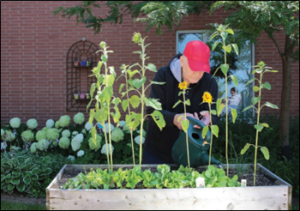
Engaging in Meaningful Activities

With summer here at last, we find ourselves engaging more fully with the world around us. Finding meaningful activities in keeping with the warmer season is a great way to keep a loved one active and involved. According to researchers Barbara J. Harmer and Martin Orrell, meaningful activity was found to be “part of human nature, which can provide structure to life and meaning to individuals.
It enables opportunities for pleasurable experiences, improves quality of life and promotes wellbeing and health. Meaningful activity is really anything that has significance to the person and has a purpose, and includes daily routines.” The benefits of meaningful activity also include the following:
- Enhancing dignity and self-esteem
- Giving pleasure and a sense of fulfillment
- Providing structure and a stabilizing routine
- Providing comfort
- Capitalizing on abilities for as long as possible
- Allowing the care partner to do things with and for their person
- Satisfying and enjoyable to the persons involved
- Providing meaning, particularly if you focus on the process and not on the outcome
It is important to ensure that activities are based on individual abilities and to remember that there is no wrong way to do an activity, as long as the person is satisfied. Set up activities before asking person to take part and even consider including them in helping with the preparation. Provide options for the person to choose from and offer one direction at a time as needed.
Here are some ideas for activities that you and your person may find interesting whether indoors or outdoors in a lovely and cool area in the shade:
- Set up arts and crafts, such as painting, coloring, sketching or knitting – keep tools and patterns simple. Rolling balls of yarn can be very satisfying to the individual
- Organize household or office items, particularly if the person used to take pleasure in organizational tasks. Include paper work by setting up filing opportunities
- Clean around the house. Sweep the floor, wipe the table, fold towels or try other household tasks that help the person feel a sense of accomplishment, such as reorganizing drawers or polishing silverware
- Tend to indoor or outdoor gardens, plants and planters
- Read the newspaper, magazines and talk about current events
- Sing songs or play music from a favourite movie or TV show
- Look at the person’s favourite books – consider that audio books may be of interest if reading is now a challenging activity
- Follow a simple recipe and cook or bake together – include clean-up of the activity after, as long as the person is not too tired
- Work on a puzzle – consider its size and difficulty level
- Watch family videos
- Cut and shred items, such as coupons or papers
- Count, sort and organize items, such as coins, coupons, tools, buttons, or junk drawers
- Consider the person’s interests and occupation. Perhaps there’s a skill from a job that you may be able to tap in to, such as math, music, sports, gardening, or Sunday school teaching
- Forget about what you or society thinks about acceptable activities or objects: If a person has always loved babies or pets, a doll or stuffed animal may be enjoyed
- Incorporate physical activity into your day, whether through helping tasks, gardening, taking a walk or following a simple exercise program – movement can increase energy, mood and the ability to think and focus
It is important to take a flexible, supportive approach. If your person resists an activity, take a break. You can try again later or ask your loved one how the activity can be changed to make it more enjoyable for them next time. Remember to concentrate on the process of an activity and not the results. It does not matter if you never get the puzzle put together or that the activity is not exactly the way you would do it yourself. What matters is that your person enjoyed the time spent on it and felt helpful in the process.